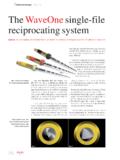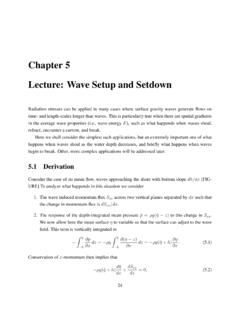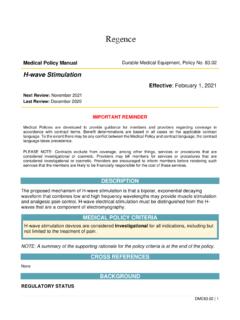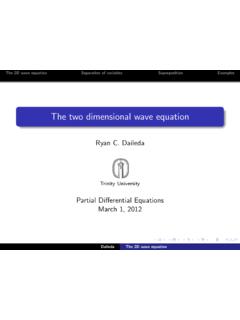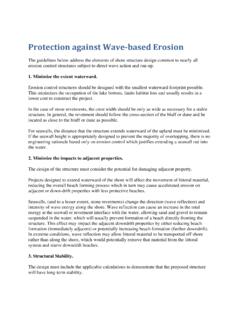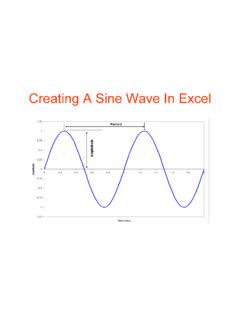Transcription of Parameters - Cornell University
1 1 WavesKrauss Chapter NineWaveParameters Wavelength = = Length between wave crests (or troughs) Wave Number = = 2 / (units of 1/length) Wave Period = T = Time it takes a wave crest to travel onewavelength (units of time) Angular Frequency = = 2 /T (units of 1/time) Wave Speed = C = / Distance a wave crest travels per unittime (units of distance/time) Wave Height = 2a = Twice the wave amplitude Wave Steepness = Wave Height/Wavelength2-Ideal waves Propagate Energybut not MassWave EquationNavier-Stokes EquationIgnoring viscous forces and looking just at the x and the a solution for Eq.
2 3 of the 4 Plug Eq. 4 into Eq. 3 to yield the following differential 5Eq. 1Eq. 2 These equations usedto establish (see Krauss)Eq. 3 This expressionsolved to obtainwave (see Krauss)Eq. 5 One solution to Eq. 5 lower boundary condition requires that w ( d /dz) go tozero at z = h (h is the seafloor depth) (see Krauss)The boundary condition at the free surfacemust satisfy the following expression (see Krauss)The lower boundary condition requires B=0 The free surface boundary condition requires (see Krauss)..Eq. that the phase velocity can be written as C = / it follows velocity as a function of wavenumber and water depthEq.
3 7 Also known as the dispersion relation ofLamb (1945) h < /20 For h > Wave Speeds - Deep-Water waves (Bottom Depth > /2) Speed is a Function of Wavelength Only waves with Longer Wavelength move faster thanWaves with Shorter Wavelength Shallow-Water waves (Bottom Depth < /20) Speed is a Function of Depth Only waves Travel Slower in Shallower Water Irrespectiveof Wavelength as long as Depth < /20 Deep-Water and Shallow-WaterWave Regions6 Speed of Deep-Water and Shallow-Water waves as a Function ofWavelength and DepthImportant Consequences of WaveSpeed Dependency on Wavelengthor Bottom Depth7 Wave Dispersion: Self Sorting of Deep-Water waves Leaving aStorm Region based on Wavelength.
4 It Occurs Because LongerWavelength waves Travel Faster than Shorter WavelengthWaves (for Deep Water).Bending of Shallow-Water WaveFronts Due to Change in BottomDepth. The Leading Edge of aWave Front Enters ShallowerWater and Slows While theRemaining Front Continues atHigher Speed. The Net Result isa Rotation of Wave Fronts ToBecome Parallel with BottomDepth Refraction:8 Consequence of Wave RefractionFocusing and Defocusing of Wave Energy on Headlands andBays, RespectivelyGroup Velocity9 Group VelocityGroup Wave Speed = C = / for:Then by the a trigonometric = / or = C The Main Point: Group velocity for Deep Water waves is 1/2 the phasevelocity.
5 Group velocity for Shallow Water waves is equal to the Spectra11 Spectral AnalysisTime Domain to Frequency Domain TransformationSpectral AnalysisTwo Sine waves at 260 Hz and 525 Hz, Respectively12 Spectral AnalysisTime Series derived from the Summation of the TwoSine WavesSpectral AnalysisFourier Transform from Time Domain to FrequencyDomain of Previous Time Series13 Distribution of Wave Energy in the Ocean as a Function ofWave Frequency or Wavelength14 Aliasing in Wave Sampling15 Wave of Wind - the distance over which wind can blow withoutobstructionWave Height of Wind-Generated waves is aFunction Developed waves (Unlimited by Fetch and Duration)
6 16 The Importance of FetchNortherly/Southerly Winds Produce a Long Fetch OverFinger Lakes (A), and Easterly/Westerly Winds Produce aShort Fetch (B)ABFetch in the Open Ocean is Limited by the Sizeof the Storm System17(95% of Energy Contained Within 45o of Storm Direction)Lateral Spreading of Wave Energy from a StormSourc
